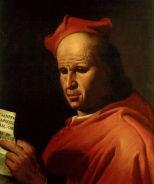Raniero Capocci
Raniero Capocci or Rainer von Viterbo (* between 1180 and 1190 ; † May 27, 1250 in Lyon , buried in Citeaux ) was a cardinal of the Roman Catholic Church . He came from Viterbo.
Life

The news that Rainer was a Cistercian and abbot of Tre Fontane goes back to the first volume of the Italia Sacra from 1644 by Ferdinando Ughelli , who himself was the abbot of this monastery. There are no contemporary sources for this, but he and Jakob von Pecoraria were among the representatives of Cistercian interests in the College of Cardinals. Since he belonged to the ordo of cardinal deacons all his life , he probably did not have the necessary degrees of ordination to exercise the office of abbot. Under Pope Innocent III. he was appointed notary and in the spring of 1216 cardinal deacon of Santa Maria in Cosmedin . As papal legate he was active in Languedoc during the Albigensian Crusade , where he made the acquaintance of Domingo de Guzmán , whose newly founded order he then promoted in the Curia in Rome . From Pope Honorius III. he was appointed rector of the patrimony in Tuszien and vicar of his hometown Viterbo.
In 1234 Raniero appeared as field commander of papal troops in the fight against the revolting urban population of Rome. With the support of imperial troops, he brought Viterbo back under papal control, and he was able to successfully repel a subsequent relief of the Romans in a battle. In the spring of 1235, the Romans again submitted to the suzerainty of the Pope.
In the conflict that broke out between Pope and Emperor in 1239, Raniero was a staunch opponent of Emperor Frederick II , whom he fought propagandistically with pamphlets in particular. This enmity was intensified by the voluntary submission of the Viterbes to the emperor in 1240. In the manifesto "Ascendit de Mari", which he commissioned Pope Gregory IX. wrote, Raniero defamed the emperor as an antichrist and as a beast destroying the Catholic world. Under Pope Innocent IV , he became the head of the war party against the emperor within the college of cardinals . In September 1243 he brought Viterbo back to the papal camp and took over the subsequent successful defense of the city against an imperial army, actively supported by the young Rosa von Viterbo .
After the Pope fled to Lyon in 1244 , Raniero stayed in Italy to continue the fight there. In 1245 Viterbo was attacked and sacked by the emperor, whereupon Raniero intensified his propaganda, which contributed significantly to the banishment of the emperor at the Council of Lyon . In 1246 he was defeated together with a Guelfish army from Perugia and Assisi in a field battle, and in 1247 Viterbo was recaptured by the emperor. After the bishop Marcellino of Arezzo was sentenced and executed by an imperial court in 1248, Raniero finally called for the annihilation of the Hohenstaufen ( destroy the name and body, offspring and seeds of this Babylonian! ).
He died on May 27, 1250, a few months before the emperor. He was buried in Citeaux, in Viterbo a monument was erected in front of the main altar of the church of Santa Maria dei Gradi, which he built.
In 1249 Raniero had officially confirmed the establishment of the Servite Order . The mathematician Leonardo Fibonacci dedicated the text Flos super solutionibus quarumdam questionum ad numerum et ad geometriam uel ad utrumque pertinentium to him .
literature
- Elisabeth von Westenholz: Cardinal Rainer von Viterbo. Winter, Heidelberg 1912 ( Heidelberg Treatises on Middle and Modern History 34, ZDB -ID 501556-x ).
- Norbert Kamp : CAPOCCI, Raniero (Raynerius de Viterbio, Rainerius, Ranerius, Reinerius). In: Alberto M. Ghisalberti (Ed.): Dizionario Biografico degli Italiani (DBI). Volume 18: Canella – Cappello. Istituto della Enciclopedia Italiana, Rome 1975, pp. 608-616.
- Tommaso di Carpegna Falconieri: Ranieri di Viterbo . In: Enciclopedia Federiciana , Volume 2, Rome 2005, pp. 561-563. ( Online at treccani.it)
- Ferdinand Gregorovius : History of the city of Rome in the Middle Ages. Published by Waldemar Kampf. Complete and revised edition in four volumes after the edition first published in 1953–1957. CH Beck, Munich 1978, ISBN 3-406-07107-4
- Werner Maleczek : Pope and College of Cardinals from 1191 to 1216. The cardinals under Celestine III. and Innocent III. Verlag der Österreichische Akademie der Wissenschaften, Vienna 1984, ISBN 3-7001-0660-2 , pp. 184-189 ( publications of the historical institute at the Austrian cultural institute in Rome. 1st section: essays 6), (also: Innsbruck, Univ. , Habil.-Schr., 1978).
Web links
- CAPOCCI, O.Cist., Raniero. In: Salvador Miranda : The Cardinals of the Holy Roman Church. ( Florida International University website), accessed July 12, 2011.
Individual evidence
- ^ Anniversary of death according to Maleczek, p. 188.
- ↑ Details from Norbert Kamp in the Dizionario biografico degli Italiani
| personal data | |
|---|---|
| SURNAME | Raniero Capocci |
| ALTERNATIVE NAMES | Rainer von Viterbo; Raniero Capoccius |
| BRIEF DESCRIPTION | Italian clergyman, cardinal of the Roman Catholic Church |
| DATE OF BIRTH | between 1180 and 1190 |
| DATE OF DEATH | May 27, 1250 |
| Place of death | Lyon |